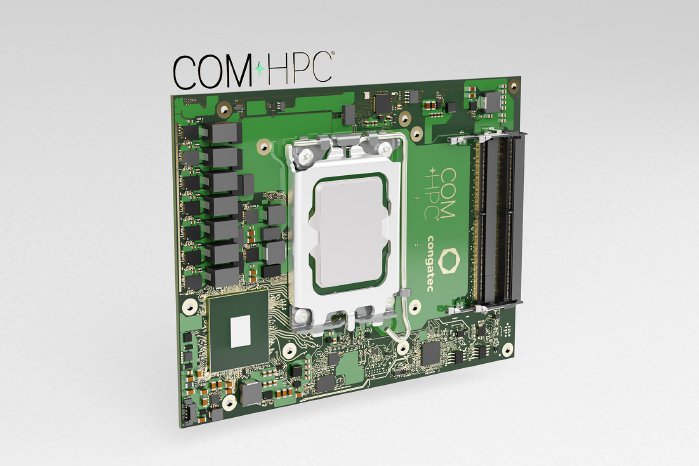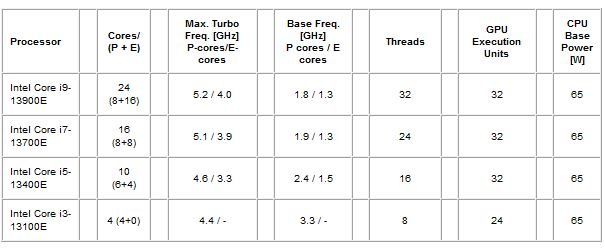"With currently up to 8 Performance cores in parallel to 16 Efficient cores, the socketed variants of the 13th Gen Intel Core processors empower our COM HPC modules to offer even more options for making edge computing more performant and efficient through workload consolidation," explains Jürgen Jungbauer, Senior Product Line Manager at congatec. IoT-connected systems have many tasks to process in parallel, and if OEMs do not want to realize this connectivity through adaptive systems, OEMs need to embed virtual machines into their solutions. The more cores a Computer-on-Module provides, the easier this becomes.
Major features that have been improved
The most remarkable improvement of the socketed 13th Gen Intel Core processors is the up to 34 % multi-thread and up to 4 % single-thread performance gain[1] as well as an impressive 25 % faster image classification inference performance[1], compared to 12th Gen Intel Core processors. The added DDR5-5600 support as well as an increased L2 & L3 cache on select variants contribute to even more outstanding multi-threaded performance. The computing core improvements of this performance hybrid architecture, which currently provides up to 8 Performance cores and 16 Efficient cores, are complemented by enhanced USB3.2 Gen 2x2 bandwidth of up to 20 Gigabit per second on the new congatec COM-HPC Size C Computer-on-Modules.
Application engineers can deploy the new COM-HPC Computer-on-Modules on congatec’s Micro-ATX Application Carrier Board (conga-HPC/mATX) for COM-HPC Client type modules to instantly capitalize on all the benefits and improvements of these new modules in combination with ultrafast PCIe connectivity.
For more information on the new conga-HPC/cRLS Computer-on-Module in COM-HPC Size C form factor, its tailored cooling solutions, and congatec’s implementation services please visit https://www.congatec.com/en/products/com-hpc/conga-hpccrls/
For more information on congatec’s 13th Gen Intel Core processor based embedded and edge computing solutions please visit
https://www.congatec.com/en/technologies/13th-gen-intel-core-computer-on-modules/
[1] 13th Gen Intel® Core™ processor compared to 12th Gen Intel® Core™ processor, measured by Intel as of November 2022. Results are estimated based on measurements on Intel® internal reference validation platforms.
Faster single-thread performance: SPECrate2017_int_base (1-copy) using InteI® Compiler version 2022.1.
Faster multithread performance: SPECrate2017_int_base (n-copy) using InteICompiler version 2022.1.
Faster CPU image classification inference performance: MLPerfInference Edge v2.1 Inference ResNet-v1.5; MLPerfInference Mobile v1.1 MobileDet-SSD; results not verified by the MLCommonsAssociation.
New configurationProcessor: Intel® Core™ i9-13900E QDF Q1JB 8P+16E, 65W TDP, 5.2 GHz TurboGraphics: Intel® UHD Graphics 770 with 32 EUsMemory: 2x 32GB DDR5 5200MHzStorage: NVMeWD_BLACK SN750 SE 500 GBPlatform: Intel® RPL-S ADP-S DDR5 UDIMM CRBOS: Windows 10 Enterprise (x64) Build 19044.1387 (21H2)BIOS: RPLISFI1.R00.3301.A03.2209021017
Baseline configurationProcessor: Intel® Core™ i9-12900E QDF QYMF 8P+8E, 65W TDP, 5 GHz TurboGraphics: Intel® UHD Graphics 770 with 32 EUsMemory: 2x 32GB DDR5 4800MHzStorage: NVMeWD_BLACK SN750 SE 500 GBPlatform: Intel® AlderLake-S ADP-S DDR5 UDIMM CRBOS: Windows 10 Enterprise (x64) Build 19044.1387 (21H2)BIOS: ADLSFWI1.R00.3267.B00.2206270714



